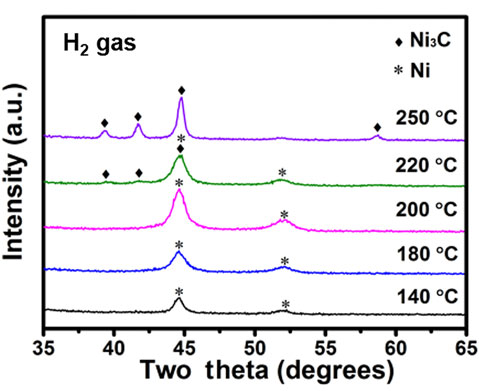Crossref Citations
This article has been cited by the following publications. This list is generated based on data provided by
Crossref.
Eadi, Sunil Babu
Song, Hyeong-Sub
Song, Hyun-Dong
Oh, Jungwoo
and
Lee, Hi-Deok
2019.
Nickel Film Deposition with Varying RF Power for the Reduction of Contact Resistance in NiSi.
Coatings,
Vol. 9,
Issue. 6,
p.
349.
Prokopyev, D. A.
Germov, A. Yu.
Mikhalev, K. N.
Uimin, M. A.
Yermakov, A. E.
and
Konev, A. S.
2019.
NMR study of phase composition of carbon encapsulated Ni@C nanoparticles.
Vol. 2174,
Issue. ,
p.
020155.
Mikhalev, K N
Germov, A Yu
Prokopyev, D A
Uimin, M A
Yermakov, A Ye
Konev, A S
Gaviko, V S
and
Novikov, S I
2019.
NMR study of magnetic nanoparticles Ni@C.
Journal of Physics: Conference Series,
Vol. 1389,
Issue. 1,
p.
012137.
Kim, Minsu
Nabeya, Shunichi
Nandi, Dip K.
Suzuki, Kazuharu
Kim, Hyun-Mi
Cho, Seong-Yong
Kim, Ki-Bum
and
Kim, Soo-Hyun
2019.
Atomic Layer Deposition of Nickel Using a Heteroleptic Ni Precursor with NH3 and Selective Deposition on Defects of Graphene.
ACS Omega,
Vol. 4,
Issue. 6,
p.
11126.
HU, Yulian
TIAN, Xu
FAN, Qipeng
WANG, Zhengduo
LIU, Bowen
YANG, Lizhen
and
LIU, Zhongwei
2019.
Fabrication and characterization of iron and iron carbide thin films by plasma enhanced pulsed chemical vapor deposition.
Plasma Science and Technology,
Vol. 21,
Issue. 10,
p.
105502.
Chen, Sen
Zhang, Xiangyu
Liu, Bowen
and
Liu, Zhongwei
2022.
Pulsed chemical vapor deposition of cobalt and cobalt carbide thin films.
Journal of Vacuum Science & Technology A,
Vol. 40,
Issue. 2,
Du, Liyong
He, Dongmei
and
Ding, Yuqiang
2022.
A “Fraternal Twin” atomic layer deposition process for nickel carboxylate and nickel carbide.
Inorganic Chemistry Communications,
Vol. 137,
Issue. ,
p.
109235.
K.C., Anupam
Siddique, Anwar
Anderson, Jonathan
Saha, Rony
Gautam, Chhabindra
Ayala, Anival
Engdahl, Chris
Holtz, Mark W.
and
Piner, Edwin L.
2022.
Preferentially oriented growth of diamond films on silicon with nickel interlayer.
SN Applied Sciences,
Vol. 4,
Issue. 8,
Potocnik, Jelena
and
Popovic, Maja
2022.
The effect of thickness and deposition angle on structural, chemical and magnetic properties of nickel slanted columns.
Science of Sintering,
Vol. 54,
Issue. 4,
p.
449.
Deng, Hao
Chen, Ziqi
Chen, Yuanzhi
Mei, Jie
Xu, Wanjie
Wang, Laisen
and
Peng, Dong-Liang
2023.
Nickel submicron particles synthesized via solvothermal approach in the presence of organic bases: Formation mechanism and magnetic properties.
Colloids and Surfaces A: Physicochemical and Engineering Aspects,
Vol. 661,
Issue. ,
p.
130971.
Nagar, Swati
Mukherjee, G. S.
and
Banerjee, M.
2023.
Structural and Magnetic Properties of Ni Nanoparticles Embedded in Vinyl Polymer Nanocomposite Films.
SPIN,
Vol. 13,
Issue. 02,
Wang, Jie
Yuan, Chen
Li, Claudia
Geng, Guanlong
Song, Jian
Yang, Naitao
Kawi, Sibudjing
Sunarso, Jaka
Tan, Xiaoyao
and
Liu, Shaomin
2025.
Nickel-based metallic membranes for hydrogen production in membrane reactor: A brief overview.
Separation and Purification Technology,
Vol. 358,
Issue. ,
p.
130435.
